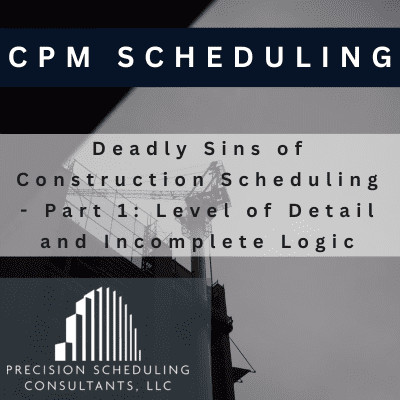Understanding Common Construction Scheduling Errors
Construction scheduling involves numerous rules, requirements, guidelines, and legal precedents. Throughout my career as a scheduler, schedule analyst/reviewer, and claims expert, I have encountered various common errors. This article highlights those errors to enhance your understanding of effective construction scheduling.
1. Level of Detail
One significant error arises from the level of detail in a schedule. A schedule lacking sufficient detail offers limited usefulness for tracking and monitoring projects. For instance, if critical tasks lack clarity, project managers may miss essential milestones. On the other hand, if a schedule becomes excessively detailed, it can become convoluted and confusing. Consequently, this complexity hinders effective tracking and monitoring. Being mindful of the level of detail and incomplete logic can greatly improve scheduling.
To strike the right balance, maintain activity durations between 1 and 20 working days. Activities that last just one day often lack sufficient context for tracking progress effectively. Instead, opt for durations that allow for adequate planning, execution, and monitoring. By finding that middle ground, you’ll create a schedule that functions both as a useful tool and as a comprehensive overview of the project timeline.
2. Incomplete Logic
Another common error involves incomplete logic within the schedule. Every activity must have at least one predecessor and one successor. This requirement establishes clear relationships between tasks, fostering a better understanding of the project flow. Without proper logical connections, you risk creating disjointed workflows that could derail your project. This is often referred to as having a high level of detail and incomplete logic.
Moreover, ensure that both the start and finish of each activity logically tie into the overall schedule. This logical framework creates a sequence that team members can follow, ultimately leading to improved efficiency. The only exceptions to this rule are the first and last activities in the schedule since they inherently lack preceding and succeeding tasks.
3. Lack of Updates
Beyond level of detail and logical connections, schedules must undergo regular updates. Failing to update a construction schedule can lead to outdated information and misinformation among stakeholders. Regular updates allow for adjustments based on actual progress, enabling accurate tracking of project milestones.
Additionally, when team members observe timely updates, they remain more engaged and aware of changes that may impact their work. So, make it a priority to communicate updates with your team consistently. Regularly review the schedule, assess completed tasks, and account for any delays or changes in scope. Without regular updates, the level of detail and incomplete logic issues will only become more pronounced.
4. Ignoring Resource Allocation
Lastly, consider resource allocation when developing your schedule. Neglecting this aspect can result in conflicting schedules and inefficiencies. To prevent this, analyze available resources and align them with project timelines. This strategy ensures the right personnel and equipment are available when needed.
Furthermore, resource allocation directly impacts the overall timeline. For example, if a critical resource becomes unavailable, project delays could occur. Thus, proactively managing resources leads to smoother project execution and improved outcomes.
Close Out
Constructing an effective schedule requires attention to detail, logical structure, regular updates, and resource allocation. By avoiding these common errors, you can create a schedule that serves as a reliable guide for project execution. Implementing these strategies not only enhances project accuracy but also fosters team collaboration and engagement throughout the construction process. Moreover, addressing level of detail and incomplete logic at each stage can significantly improve results.


